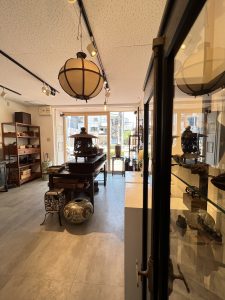本日の快晴の空を眺めながら(愛知県名古屋市千種区姫池通 骨董買取 古美術風光舎)
2024.11.21
みなさまこんにちは、スタッフYでございます。

今日の名古屋は素晴らしい秋晴れです。少々風はありますが、こんな日は若い子たちはおしゃピクとかするのでしょうか。そんな空を羨ましく眺めながら本日もブログ綴っていきたいと思います。
最近絵画の買取をご希望されるお客様が多いのですが、その際に画の状態などを拝見いたします。圧倒的に風景画が多いのですが、やはり海、山や建物、そして空が多く描かれております。描き方は様々、「空」一つにも作家によってこんなにも捉え方が違うのか…と、驚きます。また、有名な西洋画ですと、ゴッホの空なんて雲がトグロを巻いてなんだか混沌とした気持ちになったり、モネの「日傘をさす女性」なんて空に流れる雲が爽やかな気持ちにさせてたり。西洋画では雲が作家の心理描写をあらわすことのできる特徴的なアイテムのように私には伝わります。
なぜそんなことを思ったのかと言いますと、9月から開催されている東京・渋谷区立松濤美術館の「空の発見」という展覧会が先日まで開催されていたようでして。残念ながら行くことはできなかったのですが、かつての日本美術には青い空に白い雲の表現がほとんど出てこないということを、これまでの歴史的な流れと共に作品を通して知ることが出来る展覧会だったようでして、それぞれの時代やお国での「空」の描き方が気になってきました。
そういえば先日訪れた相国寺展の応挙や若冲などの画もそうでしたが、日本のかつての絵画はそういうものだと無意識のうちに「そんなもんだ」と、我々は認識しておりますが、そういえば「空」なんてなかったな笑と、今さら気が付きました。
もう少し詳しく調べて見ますと、近世以前では「金雲」とか「一文字ぼかし」などが定番の表現し、屏風絵などのイメージを思い浮かべるとこれがお決まりの空の描き方でありました。西洋美術の影響を受ける前の日本美術における空の扱いは演出効果であったり、空があることを示す記号的表現であったり、文字入れのための余白として描かれるものであり、自然現象として描写する対象ではなかったようです。
私がこのイメージで思い出すのが「洛中洛外図屏風」なのですが、これまで多くの絵師により描かれておりますが、どの「洛中洛外図屏風」も視覚効果とダイナミックな場面の展開を空じゃなくて雲によって上手く使っているというか、ストーリを持たせていますよね。
国宝 紙本金地著色洛中洛外図(舟木本) (※)右隻 東京国立博物館蔵より
詳しくは、画面を覆う「金雲」「すやり霞」といった手法というようですが、現実の空を描写したものではなく、視覚効果をもたらす演出としての表現様式のひとつ。西洋の概念にどっぷり浸かった現代の目からすると、これらはむしろ画期的に感じるのでしょうか。ですが、受け継がれた遺伝的な刷り込みもあるのでしょうか、我々には「金」で表現されていても誰もが「雲」だとわかりますし、そこが「空なんだ」ともわかります。逆に西洋の方にはこの金のもこもこは何に見えるのでしょうね。
また、場所や時間が異なる場面同士を繋ぎ余計なものを省いて見せたいものを際立たせ、画面を華やかに装飾する効果も。「繋ぐ」「省く」「飾る」と複数の機能を持ち合わせて、なんてかわいらしくて面白い手法だろうと思います。
そんな「空や雲」という表現が一般化するのは近世以降でして、西洋の影響を受けた洋風画や泥絵、浮世絵などを中心に、日本の絵画にも青空が広がり始めるのです。また、プルシアンブルーの輸入もそれを後押ししたようでして、それまで描きたい対象にフォーカスして描いていた日本美術は、この泥絵のように視野を切り取る=視野を一点に固定する表現を試みるようになります。ですが、当時の日本人にとって斬新なルールであったため、必ずしも好まれたわけではなかったようです。これまで描きたいものを描きたいように描いてきたのですから当然でしょうね。
そんな日本人はが次に編み出したのは、浮世絵の空の表現の一文字ぼかし。
横にまっすぐ色を乗せてグラデーションにぼかし、天気や時節を表す。「ここに空がある」という記号的表現しています。朝の日本橋を描いた画像左では、上部が青色(天ぼかし)で、下部がオレンジ色(地ぼかし)となっており、画像右の後年に版を変えて刷った異版「変わり図」では色が逆転しています。色の表現を変えて時節をかえて表現しています。その後、日本にも西洋画の波が押し寄せてきますが、本日はここまでとして、つづきは次回といたします。
ご興味ありましたら、次回も是非お付き合いください。
それではごきげんよう。
Hello everyone, this is Staff Y.
It is a beautiful autumn day in Nagoya today. There is a bit of wind, but I wonder if young people are having a picnic on a day like this. I would like to write this blog today while looking at such a sky with envy.
Recently, we have had many customers who wish to purchase paintings, and at that time, we inspect the condition of the paintings. The overwhelming majority of the paintings are landscapes, with many depicting seascapes, mountains, buildings, and the sky. The way of painting varies, and it is surprising to see how differently even a single “sky” is perceived by different artists. In famous Western paintings, Van Gogh’s sky is somewhat chaotic with clouds rolling in a sprawling pattern, while Monet’s “Woman with a Parasol” is refreshing with clouds flowing in the sky. In Western painting, clouds seem to me to be a characteristic item that can express the artist’s psychological portrayal.
The reason why I was thinking of this is that an exhibition titled “Discovering the Sky” at the Shoto Museum of Art in Shibuya, Tokyo, which has been held since September, was on until the other day. Unfortunately, I was not able to go to the exhibition, but it seemed to be an exhibition where I could learn through the artworks, along with historical trends, that in the past, expressions of white clouds against a blue sky rarely appeared in Japanese art, which made me curious about how the “sky” was depicted in each period and country.
Come to think of it, the paintings by Okyo and Jakuchu at the Shokokuji temple exhibition that we visited the other day were like that, and we subconsciously recognize that that is how Japanese paintings used to be, but now that I think of it, I realized that there was no such thing as “sky”.
A closer look reveals that “golden clouds” and “Ichimonji bokashi” were the standard expression in pre-modern times, and when one thinks of images such as folding screen paintings, this was the standard way of depicting the sky. Before the influence of Western art, the sky in Japanese art was treated as a dramatic effect, a symbolic expression indicating the existence of the sky, or as a blank space to put text, not as a natural phenomenon to be depicted.
The details of this painting are said to be the “golden clouds” and “suyarimasumi” that cover the screen, but it is not a depiction of the real sky, but a style of expression that creates a visual effect. From the perspective of modern eyes immersed in Western concepts, these techniques may seem rather revolutionary. However, perhaps it is a genetic imprint that has been passed down from generation to generation, and everyone can tell that even if it is expressed in “gold” to us, it is a “cloud,” and that is “the sky. On the other hand, I wonder what these gold motes look like to Westerners. Also, by connecting scenes of different places and different times, the effect is to highlight what you want to show by omitting unnecessary things, and to decorate the screen in a gorgeous way. I think it is a cute and interesting technique that has multiple functions of “connecting,” “omitting,” and “decorating.
The next thing that these Japanese developed was the one-character blurring of the sky expression in ukiyo-e prints.
Hiroshige Utagawa, Nihonbashi in the Fifty-three Stations of the Tokaido, Edo period
The colors are placed straight across and blurred into a gradation to represent the weather and the time of day. The symbolic expression “here is the sky” is used. In the image on the left, which depicts Nihonbashi in the morning, the upper part is blue (tenbokashi) and the lower part is orange (jibokashi), while the colors are reversed in the different edition “Henkaizu” on the right, which was printed in a different edition later. In the different edition of “Henka-zu,” printed from a different plate in later years (right), the colors are reversed. Later, the wave of Western-style paintings came to Japan, but that’s all for today.
If you are interested, please come back next time.
Have a good day.
Translated with DeepL.com (free version)



